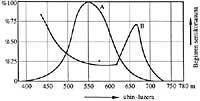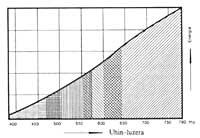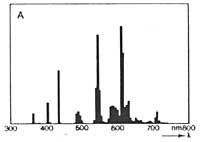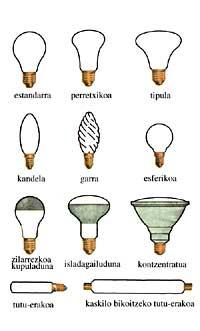Artificial illumination of plants
1990/01/01 Mujika, Alfontso - Elhuyar Fundazioa Iturria: Elhuyar aldizkaria
Illumination for photosynthesis
Photoperiodic illumination
At present, in the upper greenhouses, all the factors that govern the development of the plants are controlled and used. One of these factors is illumination. For this purpose it is necessary to know, first of all, the photobiological processes that occur in the plants, in order to understand the influence of artificial lighting. The truth is that all this is not new, since about 60 years ago the artificial lighting of the plants began to be used, but it is true that it will still be something new for many people.
In the Basque Country, intensive crops and greenhouses are rapidly reproducing in recent years and artificial lighting may be relocated here. We do not want to say that from now on they should be planted in the vegetable gardens, but artificial lighting for some greenhouse crops is certainly interesting.
Since the emergence of the so-called Industrial Agriculture, the human being has used all the ways to alter the natural development of the plants, to influence the flowering, to improve the quality of the plants and the fruits, to accelerate their growth, as well as to modify the times and times of harvesting of the harvest and therefore of sale of the product, always looking for economic profitability. It is intended to be cultivated in controlled conditions throughout the year, overcoming cycles and natural epochs. Networks, plastics and crystals are used to cover farmland or vegetable gardens: they are greenhouses.
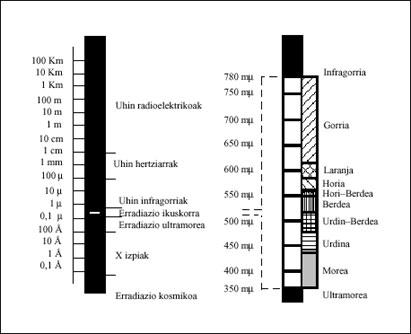
The greenhouses allow an easy control of the temperature and the watering. But the road has not finished there. From there all the other factors are controlled in high level greenhouses, which today have become closed production systems, called "green factories".
Among the growth factors of the plants, the illumination is decisive, since it participates in the production, development, flowering and fructification of the plant. In the horticultural industry, natural light –the sun– and artificial light are used together. Therefore, the different light sources, luminaires and different lighting systems are part of the production process; water, temperature, fertilizers, etc. As many as they are.
The light acts on the plants through three basic processes: photosynthesis, photomorphogenesis and photojournalism, whose importance varies depending on the physiology of each plant.
Photosynthesis Photosynthesis
As is known, the plants produce organic compounds and oxygen from water and carbon dioxide (inorganic compounds), but for this they need light as energy source. The luminous energy is absorbed by the pigments of the plants (chlorophyll) and the water in the air and CO 2 is transformed into carbohydrates by physical-chemical reactions. This metabolic process is called photosynthesis. In this way, and with the mineral salts they take from the soil, the plants obtain the necessary food for their growth and development.
Photosynthesis is proportional to the duration of irradiation and luminous flux to the point of saturation. This point is different according to the plants. In addition, photosynthesis is sensitive to the spectral composition of light and plants do not have the same sensitivity as the human eye to the different wavelengths of light, that is, they do not “see” it like us. The sensitivity of the human eye is expressed in a curve with different wavelengths, curve that presents a peak for a wavelength of 555 nm (yellow-green light). Each plant has its own sensitivity curve. After a wide study of different plants, the average curve of sensitivity or photosynthesis of plants has been calmed. This curve has its peak for a wavelength of 675 nm (red light).
The amount of CO 2 that absorbs the plant depends on the wavelength of the light. Thus, the most efficient artificial lighting lamp would be the one that emits all energy at 675 nm, but it has been shown not to be so. Its cause is explained by photomorfogenesis.
Fotomorfogenesis
The composition of the spectrum of light affects the development and appearance of the plant. This phenomenon is called fotomorfogenesis. Research has shown that ultraviolet radiation has a harmful effect on the plant (which does not grow properly), that the leaves increase and the plant expands, but does not grow up. At the other end, infrared radiation hardly influences the development of the plant if it is not the calorific effect. Therefore, in the development of the plant only positively influences the beam of wavelengths that occupies the visible spectrum. That is, photosynthesis occurs throughout the entire visible spectrum. The first conclusion is clear: lamps designed for general lighting can control the growth of plants.
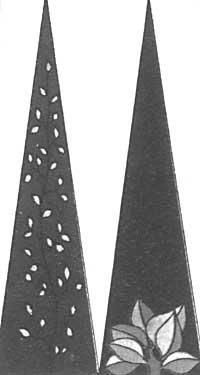
It is shown that red radiation favours the production of carbohydrates and blue radiation favours the accumulation of proteins. In studies carried out with various plants it has been observed that illuminating with red light, the plant forms small leaves and excessively long stems, while with blue light, the plant grows in sheet and tends to direct towards the light source. Therefore, a balanced light spectrum is needed. The more the spectrum of the light source resembles the photosynthetic curve of the plant, the better results will be obtained.
Photojournalism Photojournalism Photojournalism
Photojournalism is the physiological response of the plant to the relative length of the day and night. The plant needs light but also darkness to return to the atmosphere the excess of CO 2. The plants have a biological clock through which they have preset the time of flowering according to the duration of the night. In some plants, the process of obtaining only begins when the day has that duration. On the other hand, in other plants, it will only begin when the duration of the day is relatively short. Likewise, the shortening of the day will slow the growth of new riots in the wood plants or, conversely, will promote the formation of tubers like potatoes.
The plants are classified according to when the flowering occurs: they can be long day, short day and neutral daily. For example, on a short day plant, like urrelilia, a relatively long period of darkness will cause the flowering of the plant. The bell tower, for its part, will only be reached if the duration of daylight exceeds a critical value. Finally, there are plants that do not depend on the day of flowering or the length of the night, such as tomatoes.
Applications of artificial lighting
According to the above, the two main uses that can have artificial lighting in the orchard are immediately noticeable:
- Provide additional light energy that allows for additional plant growth in the darkest time of the year, i.e., illumination for photosynthesis.
- Photoperiodic illumination to control the flowering time, the most used application currently.


In addition to the two previous applications, there is the possibility that “photosynthetic” illumination will occur in closed premises in order to completely replace the sun, but for economic reasons, which are expensive, it is limited to its use when one or more of the following conditions are met:
- They only need a low irradiance level
- They require high temperature.
- Its growth is fast, occupying space only in a short period of time.
- They are small.
- They have a great price, since they are not collected in the corresponding station.
- They will be planted in the winter months of little light.
Therefore, the total substitution of natural light is used only for the rapid examination of bulbs, control of the seed of the potato sowing and for the sowing of seeds and nuts.
On the other hand, we have the scientific illumination, which is used in studies on the growth of the plants (very high levels of illumination are used) and, finally, the lighting of interior plants, that is, they do not see the sun, in whose interior are introduced plants of the aquarium (to favor the development of the aquatic plants, increasing the concentration of oxygen in the water and preventing the formation of carbonic gas to facilitate the respiration of the fish).
For the production of flowers, pot plants and vegetables throughout the year, horticulture and gardening use solar collectors such as plastic tunnels and greenhouses made of plastic or glass. In them, irrigation systems, fans and other instruments are used to achieve an additional production. In some cases the systems are very sophisticated, controlling by computer all the growth factors of the plants. All factors except illumination.
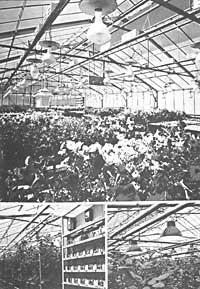
Daylight affects the production throughout the year. In the middle of spring, in summer and in the first part of autumn, daylight is sufficient to maintain the productive level. However, when the rest of the year the days are shortened a lot, the production is low, in general, being the winter production a third of the summer. Therefore, additional light will improve and expand the photosynthesis process in the greenhouse, raising the annual production level.
The use of well-selected lamps and luminaires designed to the effect lengthen the short days until reaching the necessary lighting hours. The use of artificial lighting, and depending on the type of crop, plant and latitude, allows to obtain between 30% and 40% of additive regarding the winter production standard. This type of systems are used, for example, to produce coatings, pot plants, floriculture, trees and vegetables, shortening production cycles and giving stronger plants.
The degree of illumination required for photosynthesis depends on the same plant (a radiometric magnitude called irradiance expressed in milliwatts per square meter is used). The energy values necessary for many different plants have been experienced. Typical values range between 5.000 and 20.000 mW/m 2. The arrangement of these radiometric values in photometric magnitudes requires illumination of between 2000 and 9.000 lux (illumination is a magnitude used to measure light, defined as the luminous flux per unit of surface. Its unit is lux: 1 lux = 1 lumen/m 2 ).
To obtain these levels of lighting, discharge lamps are mainly used, mainly of metal halide and high pressure sodium vapor. Why are these lamps and not those in homes, that is, incandescent or fluorescent? You can ask the question. The reason is not technical but economic. While the luminous efficiency of the incandescent lamps is of the order of 15 lumens (the luminous efficiency of a lamp is defined as the ratio between the luminous flux emitted by the lamp and the electrical power that absorbs it), that of the vapors of metal or sodium halogenuros is of the order of 80 and 100 lumen/W respectively. This means that the invoice of Iberduero would be 5.5 times greater or equal than that of incandescent lamps to obtain the same level of lighting.
In addition, the average duration of incandescent lamps is much lower than that of others. On the other hand, the luminous efficiency of fluorescent lamps is high, almost like that of metal halide lamps, but of low power, up to 65 W maximum, while in others lamps of 400 W are used. This means that with the fluorescent installation the number of lamps would be 6 times higher, that is, the most expensive installation. In addition, the dimensions of the fluorescents are large and the reflector they use is even greater, preventing natural light from entering the greenhouse and reaching the plants.
However, it should be noted that incandescent lamps are used when low irradiance values are required, and fluorescent lamps are used in low-rise locations due to their low operating temperature and uniformity of the distribution of light.
We know, therefore, what type of lamps to use, but not any of them, but we must choose those that provide most of the energy to a wavelength of between 400 and 700 nm, corresponding to the photo-synthesis curve of the plants. On the other hand, the rest of factors such as temperature, humidity, fertilizers, etc., must be adapted to the degree and time of irradiation to achieve the best growth of the plant.
Finally, it is not enough to have a suitable lamp. The lighting of the lamp will be distributed in the most uniform way possible. Taking into account that the height of the greenhouses is not very high, special luminaires are needed (they are the appliances that direct and distribute the luminous flux emitted by the lamp towards the surfaces to illuminate), diffuser type, with the minimum number of luminaires to achieve maximum uniformity.
To obtain the idea of power to install, depending on the level of lighting chosen, it can be stated that when high pressure sodium vapour lamps are used, it is usually installed between 15 and 150 W/m 2 of power (cucumbers, tomatoes, roses, carnations), with metal halide about 150 W/m 2 (urrazos) and incandescent lamps 25 W/m 2 (urrelilis).
The flowering process is controlled by the phytochrome in the plant according to the duration of the night. When the degree of phytochrome reaches its operational value, the status of the plant goes from being vegetative to being generative and begins to develop pipes, flowers or seeds. This process is used to control the time of obtaining. Thus, it occurs throughout the year without depending on the daylight corresponding to the station.
The commissioning of this process should only be done on some plant hormones, so it is enough that the lighting is carried out with a low energy level. Most flower and flower plants are sufficient to initiate the process with a illumination of between 50 and 100 lux, well below the degree of irradiance of natural light.
For photoperiodic lighting, two systems can be used: extend the daylight by connecting the light at sunset until enough hours of light or perform cyclical lighting during the night, acting the plant as a continuous illumination. For example, divide the greenhouse into three parts and light the lamps for 10 minutes on a regular basis, alternating in every third of the greenhouses 10 minutes of light and 20 minutes of darkening. This saves a lot of energy and at the same time prevents the plant from reaching the levels of phytochrome, obtaining the same effect as continuous lighting. This system is very productive with strawberries, for example.
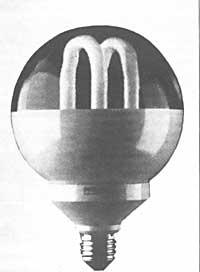
The motive light spectrum for the commissioning of the photoperiodic process is located in red, but it has been observed that the plant is less demanding and sensitive to the rest of the visible spectrum. Because the lighting level is low and the red irradiation, incandescent lamps can be used (see spectral curve figure of the incandescent lamp), but considering that it is also sensitive to other fields of the spectrum, in recent years are being used lamps of higher light efficiency, the new compact fluorescent lamps (see figure distribution of the spectrum of these lamps).
These lamps represent an important energy saving (80% and more compared to incandescent) and an average duration 8 times higher. In addition, it is demonstrated that the use of these lamps allows to obtain shorter, stronger flowers, of better quality and, therefore, of greater value, since there is not produced an elongation in mass of the stems driven by incandescent lamps by red light.
Finally, and in summary form, it can be concluded that:
- The artificial lighting or irradiation of the plants can be a very effective instrument in the orchard.
- This technique is not new, but over time a lot of experience has accumulated and has improved a lot.
- Artificial lighting allows for successful results in crops. Also the pernicious failures, since each plant plays differently and must take into account many parameters to ensure its profitability.
- Just as the previous project is currently being carried out for the lighting of a football field, an exhibition hall or a road, the projects are also made for the lighting of the heaters. And if someone were interested, before applying for a project, go to the place where these facilities are located, see it and ask, as a distrustful farmer would.

Gai honi buruzko eduki gehiago
Elhuyarrek garatutako teknologia




